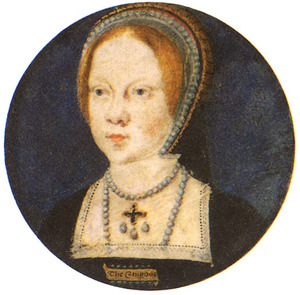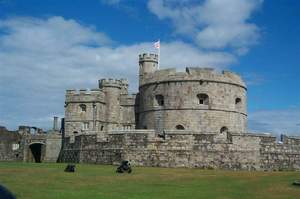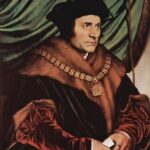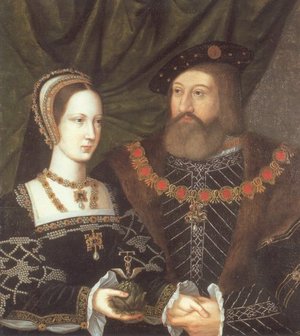Mary Tudor was the first woman to rule as Queen of England. Her story is one of tragedy, futility and turbulence that left England in a state of turmoil. It also left her with the nickname that she is known by today, Bloody Mary.
Born on February 18, 1516, she was the daughter of Henry VIII of England and Catherine of Aragon. She was their fifth born and the only child of the union that survived.
Mary was intelligent and her mother made sure that she received an extensive education. By the age of nine she could read and write Latin. She also studied Greek, music and dance.
Henry seemed to have genuine affection for his daughter even though he could not hide his disappointment at not having a male heir. He liked to show off her talents at court and she even performed a recital on the virginals at the age of four.
When she was nine, Henry sent her to preside over the Council of Wales. She had her own court at Ludlow Castle and was referred to as the Princess of Wales even though it was in name only.
When you are the daughter of a monarch, you are a political pawn and are used in whatever way is deemed the most advantageous. Negotiations for various marriages began at a very early age for Mary. At the age of two she was promised to the Dauphin of France, who was the son of King Francis I. This contract was cancelled after three years. When she was six, she was contracted to marry the Holy Roman Emperor, Charles V, who was her twenty-two year old cousin. This contract was also terminated a few years later. It was then suggested that she be contracted to King Francis himself because an alliance with France was much desired. It was decided that Mary would marry either the King or his second son, Henry, the Duke of Orleans. Despite this marriage not taking place an alliance was still achieved.
When Mary was a teenager her world was turned upside down. Her father had petitioned her mother for an annulment. Henry was desperate for an heir and wanted to marry Anne Boleyn. He was claiming that his marriage to Catherine of Aragon was cursed because she was his brother’s widow even though Catherine had sworn that her marriage to Henry’s older brother, Arthur, had never been consummated. Pope Julius II had granted a dispensation so that the two could be wed, but now Henry was claiming that the Pope had no right to grant it.
Mary was often ill. From the time she was 15 years old she suffered from irregular menstruation and depression. Compounding this, Henry would not allow Mary to see her mother who was banished from court. This no doubt caused Mary a great deal of distress.
Henry had married Anne and split from the Roman Catholic Church, forming the Church of England, with himself at its head. Catherine was now referred to as the Dowager Princess of Wales and Mary was declared illegitimate. She was no longer the Princess Mary but now the Lady Mary. She was now behind her baby sister Elizabeth in line for the throne. She lost her household; including her servants; was expelled from court and had to serve as a lady-in-waiting to the baby Elizabeth.
She refused to acknowledge that Anne was Queen in place of her mother and the constant stress of the situation caused her considerable illness. Things got so bad between Henry and her that the two did not speak for 3 years.
Unfortunately, Catherine was also ill at this time and she died in 1536 without Mary getting to see her. Mary was devastated and had no one to comfort her in her time of grief. Her pain and anger at the way her father had treated her and her mother had to have fostered a deep seated hatred for Henry and Anne.
She probably felt some form of jubilation at the execution of Anne Boleyn. The Princess Elizabeth became the Lady Elizabeth, like her half- sister before her; she was being punished for being her mother’s daughter.
Henry married Jane Seymour two weeks later. Jane tried to intercede for Mary, who refused to recognize her father as the head of the Church of England and his insistence that she was illegitimate. He eventually was able to bully her whether through intimidation or depravation into agreeing to his demands. She was allowed to return to court.
Rebels revolting against Henry’s secession from the Catholic Church insisted that Mary be reinstated as legitimate and added back to the line of succession. The “Pilgrimage of Grace” as the rebellion was called was soundly crushed and the rebels executed.
Queen Jane died a few days after giving birth to a son, Edward. Mary was made godmother of the infant and was chief mourner at Jane’s funeral.
She was given a household again and was allowed once again to live in Royal residences. She spent prodigiously on clothing and on her favorite pastime, gambling. She was courted by Duke Philip of Bavaria but because he was Lutheran he was not successful.
Cromwell, in 1539, suggested that Mary wed the Duke of Cleves, but instead Henry ended up marrying the duke’s sister, Anne of Cleves. The contract was completed before the two met in person, so even though Henry was not pleased when he saw her for the first time, there was no way to gracefully back out of the contract, so in essence he was forced to marry her.
Cromwell’s enemies sieged the moment and used the situation against him. He fell from favor and was arrested for treason in 1540. Among the charges against him was the claim that he was plotting to wed Mary himself. Whether or not it was true, the King believed it and had his old friend and supporter executed. Henry and Anne agreed to an amicable annulment and over time became close friends.
After Henry’s short marriage to Catherine Howard that ended in her execution, Mary served as her father’s hostess at court and other functions.
Henry married Catherine Parr in 1543. She was able to reunite the family and Mary and Elizabeth were restored to the line of succession behind their half-brother, Edward, though both women still remained illegitimate.
Henry VIII died in 1547 and his son was crowned Edward VI. Mary inherited estates in Norfolk, Suffolk and Essex among other properties. Edward, still being a child had a regency council led by Protestants. They enacted the Act of Uniformity 1549. This prescribed that Church rites would be Protestant. Mary, being Catholic, asked her cousin, Charles V, for protection so she could practice her religion in the safety of her own chapels.
While Edward reigned, Mary stayed mostly on her own estates and avoided court. Edward and Mary disagreed on the subject of religion and rather than arguing with him she elected to remain absent. Mary attended a Christmas court that was also attended by Elizabeth. Mary was thirty and Edward was thirteen, but they had such a heated public argument about religion that they were both brought to tears. Neither would give in to the other.
Edward VI died on July 6, 1553, when he was fifteen, presumably from tuberculosis. He did not want Mary to succeed him due to his fear that she would restore the Catholic faith to England. He was told that he couldn’t exclude Mary without excluding Elizabeth, who was a follower of the Anglican Church. He listened to John Dudley, 1st Duke of Northumberland, and disinherited them both.
They instead put forward Dudley’s daughter-in-law, Lady Jane Grey, the granddaughter of Mary Tudor, Henry’s sister and the Queen of France. Lady Jane was a cousin of both Mary and Elizabeth. John Dudley was a very ambitious man and saw the perfect opportunity to put his son, Lord Guildford Dudley, on the throne of England.
Mary was summoned to London to see her brother, but someone tipped her off, warning her that it was a trap. She escaped to East Anglia where she owned extensive properties and where Dudley had many enemies. She wrote the Privy Council on July 9th from Kenninghall, Norfolk proclaiming her succession to the throne.
On July 10, 1553, Lady Jane was proclaimed Queen by Dudley, but by the 12th Mary had assembled a military force at Framlingham Castle, Suffolk. Jane was deposed on the 19th and she and Dudley were sent to the Tower of London. On August 3, 1553, Mary entered London accompanied by the Lady Elizabeth, 800 nobles and other supporters.
Mary ordered the release of the Roman Catholic Duke of Norfolk. Knowing that the Lady Jane was just a pawn of Dudley’s, she kept her and her husband, Lord Guildford Dudley imprisoned and had the elder Dudley executed for high treason. Henry Grey, Jane’s father, was released. Almost all of the Privy Council had been involved in the plot. Mary appointed Stephen Gardiner to the council as Bishop of Winchester and Lord Chancellor. He crowned Mary on October 1, 1553.
Almost immediately Mary started searching for a husband so she could produce an heir. Her cousin, Charles V, suggested his son, Prince Phillip of Spain. Mary supposedly fell in love at first sight after seeing a portrait of him. He would be a powerful man as he would be inheriting large territories in Europe and in the New World.
The Lord Chancellor and the House of Commons tried to get her interested in an Englishman, but she had made up her mind. The idea of the marriage was unpopular in both Spain and England. Phillip was not excited about going to England, a rainy land of heretics, whereas in England, Gardiner and others did not like the idea of Mary marrying a foreigner and the Protestants feared her marriage to a Catholic.
When it became apparent that Mary was going to marry Phillip despite her country men’s reservations, Thomas Wyatt led a force from Kent to depose Mary and place the Protestant Elizabeth on the throne assisted by Henry Grey, the Duke of Suffolk; Lady Jane’s father; who apparently hadn’t learned his lesson the first time and got involved in the rebellion. Mary said she would leave the decision up to Parliament. When Wyatt reached London he was overwhelmed and captured. Wyatt, Henry Grey, Lady Jane and Guildford Dudley were all executed. Elizabeth, who protested her innocence in the rebellion was imprisoned in the tower for two months but then was placed under house arrest.
Mary was England and Ireland’s first Queen regnant. But under English common law any titles and properties belonging to a woman would pass to her husband at marriage and the fear was that Phillip would become King of England in fact instead of just name. Although Mary’s grandparents King Ferdinand and Queen Isabella of Spain kept the sovereignty of their own realms during their marriage, there was no precedent in England for this. So the terms of their marriage stated that even though Parliament would be enacted in both their names, Phillip would be King of England and laws would bear both their names; it would only be within Mary’s lifetime. England would not be obligated to supply military support to Spain in any war. Phillip could not appoint foreigners to office in England without Mary’s consent. He was not happy about the limitations but the marriage to him was purely political. He did not love Mary and agreed to the marriage only for the alliance it would create between Spain and England.
In order to make Phillip Mary’s equal in rank; Charles V gave him the crown of Naples as well as the Kingdom of Jerusalem. This made Mary the Queen of Naples and Jerusalem. They were married at Winchester Cathedral on July 25, 1554, just two days after meeting. Not knowing English, Phillip communicated with Mary by speaking a mix of Spanish, French and Latin.
Mary stopped menstruating in September, 1554. She showed symptoms of pregnancy including weight gain and nausea. Everyone believed the Queen to be pregnant. In April Elizabeth was called to court to witness the birth of the royal infant. Phillip expressed some doubt as to whether his wife was really pregnant.
April passed into May and June and still Mary didn’t give birth. Rumors started running rampant that Mary was not pregnant. She continued to exhibit signs of pregnancy until July when her abdomen suddenly went down. She apparently had suffered a phantom pregnancy. The Venetian ambassador, Giovanni Michiel was heard to proclaim the pregnancy was more likely to “end in wind rather than anything else.”
In August Phillip left England to command his armies against France in Flanders. This broke Mary’s heart and she sank into depression.
Elizabeth remained at court and Phillip, fearing that Mary, Queen of Scots, may have heirs before Mary of Elizabeth, suggested Elizabeth be married to his cousin, Emmanuel Philabert, Duke of Savoy but Elizabeth declined.
When Mary first took power she issued a proclamation stating that she would not force her subjects to worship her religion, but that didn’t last. By September the leading reformers, John Bradford, John Rogers, John Hooper, Hugh Latimer and Thomas Cranmer were imprisoned.
During her first Parliament in October 1553, she declared Henry and Catherine of Aragon’s marriage valid, effectively re-legitimizing herself and abolished the religious laws put forth by Edward VI. This restored Church law to its original form of the Six Articles, one which returned celibacy to the clergy. Priests who were married were denied their benefices.
Since she was against the break with the Roman Catholic Church, Phillip talked Mary into repealing the laws enacted by the previous ruler, affectively returning England to the Roman fold. This actually took months and the monasteries instead of being returned to the church were retained by their new owners who were powerful men. At this same time the Heresy Acts were revived and the horror began.
Many Protestants were executed because of what was called the Marian Prosecutions. Many of the richer Protestants including John Foxe went into exile, about 800 others followed suit.
Mary started executing heretics in February 1555. The men who had been imprisoned in September were some of the first to go. Thomas Cranmer, who was the Archbishop of Canterbury, was forced to watch as Bishops Ridley and Latimer were burned at the stake. He quickly recanted the Protestant faith and rejoined the Catholic Church. According to the law he should have been absolved as a repentant, but that wasn’t good enough for Mary. She had him burned at the stake anyway. Defiantly Thomas Cranmer recanted the Catholic faith in a speech while on the pyre. In all 283 people were burnt at the stake, even though the practice was frowned upon by high officials in her own government. There was a real fear that because of the cruelness of the punishment the people would possibly revolt. Unfortunately it increased the anti-Catholic and anti-Spanish sentiments among her subjects and the people who were executed became martyrs.
Reginald Pole, who was once considered a possible suitor of Mary’s had arrived at court as the papal legate from Rome in November 1554. He was ordained a priest and appointed Archbishop of Canterbury following the death of Cranmer in March of 1556. Mary relied on him for advice.
When Henry had created the Kingdom of Ireland in 1542, it had not been recognized by the Catholic Church. Mary obtained a papal bull in 1555 and the sovereignty was officially recognized. English subjects began to settle in Ireland.
King Charles V abdicated his throne in January 1556. Phillip and Mary became the King and Queen consort of Spain. Mary remained in England while Phillip was crowned in Brussels. In February Phillip negotiated peace with France. One month later, the French ambassador, Antoine de Noailles, was discovered to be involved with Sir Henry Dudley in an attempt to assemble an invasion against Mary. Sir Dudley was the second cousin of the executed Duke of Northumberland. The plot became known as the Dudley Conspiracy. Dudley stayed in exile in France while the ambassador left England in a hurry. The conspirators left in England were quickly arrested.
In March 1557, Phillip returned to England to try to persuade Mary’s assistance in a war with France. Her councilors advised against it because of the disruption of trade with France it would cause. Because of bad weather and economic decisions made during the reign of Edward VI, England was financially strapped. War was finally declared when Reginald Pole’s nephew, Thomas Stratford, invaded England with assistance from the French in yet another attempt to depose Mary. Things began to be strained between England and Rome because Pope Paul IV was a supporter of Henry II of France. In 1558 the French took Calais which caused Mary to lose prestige. England was rife with different factions and Protestant pamphlets were being circulated that fostered anti-Spanish sentiment.
During Mary’s reign the climate in England was unusually wet. The rain and floods caused famine. Despite Mary’s marriage to Phillip, England received no benefit from the Spanish conquests in the New World. Neither would she condone acts of piracy against Spanish ships because of her marriage to Phillip. She attempted to save the economy by looking for commercial opportunities and expansion of trade.
She tried to fit a modern form of government into a medieval system. There was a failure of imposing tariffs on some imports and a lot of money was lost because of this oversight. A book was published called the “Book of Rates”, in 1558 that listed the duties and tariffs of all imports. Mary appointed William Paulet, the 1st Marquess of Winchester, as surveyor of Customs and assigned him to oversee the revenue collection system.
After Phillips visit in 1557, Mary once again thought she was pregnant. Her due date was calculated as March 1558. In her will she decreed that Phillip would be regnant during the minority of her child.
Again, there was no child and Mary was forced to face the fact that Elizabeth might well be here successor.
She became ill in May 1558 and died on November 17, 1558. She was 42 years old. It is believed that she died of either ovarian or uterine cancer and it is known that she had suffered a lot of pain. Phillip claimed in a letter, “I felt a reasonable regret for her death.”
Mary left behind a legacy of turmoil and death. As time has passed she has gained the reputation of being a blood thirsty tyrant. It is possible that she took her anger and pain against her father’s treatment of her and her mother out on everyone who wasn’t a supporter of the Catholic faith or Catherine of Aragon, prompting the executions of the “heretics. For whatever reason, she will be remembered forever by her nickname, “Bloody Mary”.
Source;
en.wikipedia.org/wiki/Mary_I_of_England






